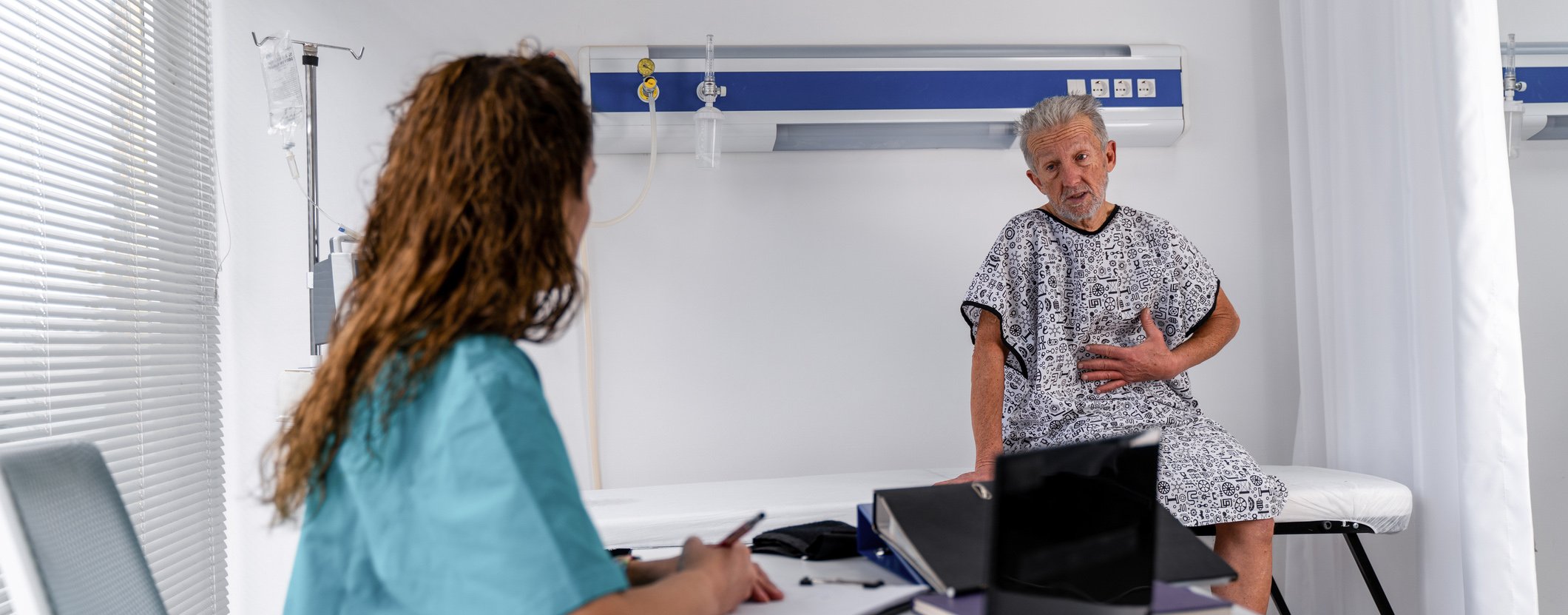The German Society of Neurology (DGN) has issued an updated S2k guideline on myositis syndromes in 2022. In recent years, new therapeutic studies have helped improve treatment strategies. There have also been some innovations in the classification of the various disease entities. The guideline contains many useful tips on anamnesis and diagnostics, including swallowing disorders.
Myositis syndromes are characterized by cellular and autoantibody-mediated muscle inflammation that manifests in a very heterogeneous manner [1]. In clinical practice, the current classification of myositides is based on clinical symptoms (distribution pattern of paresis, organ involvement, etc.), autoantibody findings, and histopathological findings. All myositides should be diagnosed in an “integrative” manner, meaning that muscle biopsy and laboratory findings (e.g., creatine kinase) as well as autoantibodies should be considered simultaneously and equally with clinical findings [2].
Autoimmune myositides are divided into the following entities [1]:
- Polymyositis (PM)
- Immune-mediated necrotizing myopathy (IMNM).
- Dermatomyositis (DM), juvenile DM
- Overlap myositis (OM)
- Anti-Synthetase Syndrome (ASyS=ASS)
- Inclusion body myositis (IBM)
In addition to the above forms of myositis, several other subtypes of autoimmune myositis exist, such as sarcoidosis-associated myositis and muscular IgG4 syndrome. However, the guideline does not address these diseases in detail.
The prognosis in idiopathic inflammatory myopathies (IIM) depends on the involvement of internal organs, especially the lungs and heart, and also on associated neoplasia [1].
| Diagnostic procedure Detailed clinical examination findings including muscle strength grades and muscle biopsy should be available for the diagnosis of myositis [3]. Sonography and muscle magnetic resonance imaging may be considered to aid in diagnosis and to locate an appropriate biopsy site. In addition, it is recommended to determine myositis-specific as well as myositis-associated antibodies. While myositis-associated antibodies are present in patients with collagenoses and concomitant inflammatory myopathy, myositis-specific antibodies are detectable in only a subset of patients with inflammatory myopathies. In all myositis, attention should be paid to the symptom of dysphagia. In particular, in inclusion body myositis (IBM), dysphagia can be severe or the initial symptom [3]. |
Drug therapy methods are predominantly empirical
Treatment of inflammatory myopathies is largely empirical, and causal therapies have not yet been established [4,5]. Glucocorticosteroids (GCS) should be used for the initial therapy of DM/PM/IMNM/ASyS/OM. Low-dose GCS therapy is suggested for long-term therapy, sometimes in combination with immunosuppressants for periods of 1 to 3 years or longer. In patients with DM, IMNM, ASyS, and PM who do not respond or do not respond adequately to ≥1 immunosuppressant, a therapeutic trial of intravenous immunoglobulins (IVIG) may be considered, with data in DM based on class I evidence. More potent immunosuppressants should be used primarily in patients with severe extramuscular organ manifestations. OM must be treated with immunotherapeutic measures in the same way as other forms of myositis.
Newer immunoselective therapies may be successful in severe courses or in cases of resistance to therapy. Therefore, in DM, PM, IMNM, ASyS, or OM, the B-cell-depleting monoclonal antibody rituximab (RTX) may be considered. Especially in case of positive “Anti-Signal Recognition Particle” (SRP) antibody status, this therapy can also be considered primarily [6–8]. Neither the detection nor the titer level of myositis-specific/associated antibodies necessarily correlate with response to RTX treatment. Therapy with RTX may be goal-directed to reduce other concurrent immunotherapies and may lead to long-term remission [6,9].
The guideline indicates that myositis patients may benefit from exercise/physical therapy concurrent with drug treatment [1,3].
| Important updates of the S2k guideline 2022 – Immune-mediated necrotizing myopathy (IMNM) has been delineated as a distinct entity. In many affected individuals, add-on treatment is already required initially to slow progression [7,15]. – Anti-synthetase syndrome (ASyS) is considered its own group alongside overlap myositis, rather than a subtype of dermatomyositis. Adequate therapy should be initiated early in ASyS with interstitial lung disease [1,3]. – Rituximab may be considered as a therapeutic alternative in refractory cases of dermatomyositis as well as polymyositis [1,3]. – Regarding inclusion body myositis (IBM), rapamycin/sirolimus has been shown to be partially effective in a phase II trial [17]. – In active dermatomyositis, IVIG (Octagam®) was newly approved based on the results in the ProDERM trial [10,19]. – Swallowing disorders can be objectified by endoscopic swallowing examinations. Experimental therapies for dysphagia include local botulinum toxin injections [1,3]. |
Intravenous immunoglobulins in dermatomyositis.
In the placebo-controlled, double-blind ProDERM study in 95 patients with dermatomyositis (DM), the use of intravenous immunoglobulins (IVIG) achieved significant therapeutic effects [1,10]. Thus, there was significant clinical improvement in the IVIG treatment arm. This resulted in the re-approval of the IVIG preparation Octagam®. Octagam® is now also approved in Switzerland for adults with active dermatomyositis in whom immunosuppressants are not effective or are not tolerated [19].
In refractory cases of DM and in polymyositis (PM), the B-cell-depleting anti-CD20 monoclonal antibody rituximab (RTX) may be considered as a therapeutic alternative. The benefit of RTX has been documented in many case series and one large treatment study [11–14]. Long-term remissions of previously refractory cases have also been reported [6].
Immune-mediated necrotizing myopathy newly recognized as a distinct entity
Among the important guideline updates, immune-mediated necrotizing myopathy (IMNM) has been delineated as a distinct entity. The guideline authors emphasize that it is important to catch this subtype of myositis early, because in many affected individuals, additional medications such as IVIG and/or RTX must already be administered initially to stop the often rapid progression of the disease [15]. Clinically, IMNM is indistinguishable from polymyositis [1]. Laboratory serology in IMNM often reveals markedly elevated creatine kinase (CK) and antibodies to “signal recognition particle” (SRP) or 3-hydroxy-3-methylglutaryl-CoA reductase (HMGCR). Histologically, diffusely distributed muscle fiber necrosis at various stages of degradation and a mild staining reaction of MHC class I associated with a low to moderately dense lymphocytic endomysial infiltrate are typically present.
Anti-synthease syndrome new as separate group
Also an important innovation is that anti-synthease syndrome (ASyS, syn. ASS) – one of the most common forms of myositis – is no longer considered a subtype of dermatomyositis, but is considered a distinct group alongside overlap myositis [16]Since pulmonary involvement is typically present in this form of myositis and is often refractory to therapy and associated with increased mortality, this entity should be consistently diagnosed, including pulmonary function testing and high-resolution chest CT. In an ASyS with interstitial lung disease (ILD), it is suggested to consider early add-on therapy with immunosuppressants or early escalation therapy (RTX, cyclophosphamide) [4,16].
Last, but not least: inclusion body myositis
Inclusion body myositis (IBM), by definition, occurs only after the age of 45 years [1]. The guideline recommends initially a 6-month trial of therapy with approximately 4-weekly IVIG infusions (initially 2 g/kg bw, then 1-2 g/kg bw). This can achieve at least a temporary stabilization of the course of the disease. Relevant dysphagia particularly justifies a therapy trial with IVIG, as positive study data are available for this. If there is a positive therapeutic effect or stabilization, IVIG therapy should be continued. The risk-benefit ratio in clinical practice is largely positive.
In addition, in a placebo-controlled, double-blind phase II study of 44 patients with IBM, treatment with rapamycin/sirolimus had a positive effect on several endpoints including Health Assessment Questionnaire (HAQ), vital capacity, muscle adiposity on MRI examination, and 6-minute walk test (6MWT) [17].
Regarding dysphagia in patients with IBM or myositis in general, the importance of a targeted evaluation is pointed out (box) .
Literature:
- Wiendl H, et al.: Myositissyndrome, S2k-Leitlinie, 2022; in: Deutsche Gesellschaft für Neurologie (Hrsg.), Leitlinien für Diagnostik und Therapie in der Neurologie. Online: www.dgn.org/leitlinien, (last accessed 03.04.2023)
- Stenzel W, Goebel HH: Recent advances in Myopathology. Neuropathol Appl Neurobiol. 2017; 43(1): 3-4.
- «Myositissyndrome», Stand: 28.4.2022, https://dgn.org/leitlinie/143, (last accessed 03.04.2023)
- Glaubitz S, Zeng R, Schmidt J: New insights into the treatment of myositis. Ther Adv Musculoskelet Dis. 2020;12:1759720X19886494.
- Smith LN, Paik JJ: Promising and Upcoming Treatments in Myositis. Curr Rheumatol Rep 2020; 22(10): 65.
- Unger L, et al: Rituximab therapy in patients with refractory dermatomyositis or polymyositis: differential effects in a real-life population. Rheumatology (Oxford) 2014; 53(9): 1630-1638.
- Allenbach Y, et al: Immune-mediated necrotizing myopathy: clinical features and pathogenesis. Nat Rev Rheumatol 2020; 16(12): 689-701.
- Aggarwal R, et al: Predictors of clinical improvement in rituximab-treated refractory adult and juvenile dermatomyositis and adult polymyositis. Arthritis Rheumatol 2014; 66(3): 740-749.
- Feist E, et al: Longlasting remissions after treatment with rituximab for autoimmune myositis. J Rheumatol 2008; 35(6): 1230-1232.
- Aggarwal R, et al: Prospective, double-blind, randomized, placebo-controlled phase III study evaluating efficacy and safety of octagam 10% in patients with dermatomyositis (“ProDERM Study”). Medicine (Baltimore). 2021 Jan 8;100(1):e23677. doi: 10.1097/MD.0000000000023677
- Tony HP, et al: GRAID investigators: Safety and clinical outcomes of rituximab therapy in patients with different autoimmune diseases: experience from a national registry (GRAID). Arthritis Res Ther. 2011;13(3):R75.
- Basnayake C, et al: Use of rituximab in histologically confirmed idiopathic inflammatory myositis: a case series. Clin Rheumatol 2015; 34(2): 371-377.
- Munoz-Beamud F, Isenberg DA: Rituximab as an effective alternative therapy in refractory idiopathic inflammatory myopathies. Clin Exp Rheumatol 2013; 31(6): 896-903.
- Oddis CV, et al: RIMStudyGroup: Rituximab in the treatment of refractory adult and juvenile dermatomyositis and adult polymyositis: a randomized, placebo-phase trial. Arthritis Rheumatol 2013; 65: 314-324.
- Allenbach Y, et al: Immune-Mediated Necrotizing Myopathies Working G. 224th ENMC International Workshop: Clinico-sero-pathological classification of immune-mediated necrotizing myopathies Zandvoort, The Netherlands, 14-16 October 2016. Neuromuscul Disord 2018; 28(1): 87-99.
- Schmidt J: Current Classification and Management of Inflammatory Myopathies. J Neuromuscul Dis 2018; 5(2): 109-129.
- Benveniste O, Horgel JY, Belin L: Sirolimus for treatment of patients with inclusion body myositis: a randomised, double-blind, placebo-controlled, proof-of-concept, phase 2b trial. The Lancet Rheumatology, Elsevier, 2021, 3(1): e40–e48.
- Zeng R, Schmidt J: Impact and Management of Dysphagia in Inflammatory Myopathies. Curr Rheumatol Rep 2020; 22(10): 74.
- Drug Information, www.swissmedicinfo.ch,(last accessed 04/03/2023).
- Cox FM, et al: Detecting dysphagia in inclusion body myositis. J Neurol 200 9; 256(12): 2009–2013.
InFo NEUROLOGY & PSYCHIATRY 2023; 21(2): 36–38.
HAUSARZT PRAXIS 2023; 18(4): 30–31












